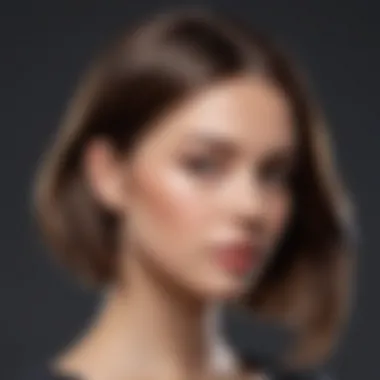Understanding the Role of Hair Experts in Beauty and Fashion


Intro
The role of hair experts in the beauty and fashion landscape is both profound and essential. With the increasing focus on personal grooming and styling, understanding what these professionals offer can greatly enhance how individuals approach their beauty routines. Hair experts, including stylists, colorists, and care specialists, are equipped with knowledge that transcends mere aesthetics. They provide insights that help people achieve their desired look while also promoting healthy hair practices.
This article aims to unpack these multifaceted roles and highlight the importance of professional guidance in hair care and styling. As we discuss trends, techniques, and sustainable practices in the hair industry, we will also consider contemporary values, such as inclusivity and environmental consciousness. By understanding these dimensions, we enable women to make informed decisions that reflect their unique style while maintaining the health of their hair.
Tips and How-Tos
Haircare and Styling Basics
Having a solid grasp of haircare is vital. Different hair types require specific care approaches. For instance, curly hair can benefit from products rich in moisture, while straight hair might need lighter formulations. Understanding one's hair type sets a foundation for effective care and styling.
Here are some essential tips for different hair types:
- Curly Hair: Use sulfate-free shampoos, leave-in conditioners, and styling gels to enhance curl definition.
- Straight Hair: Lightweight oils and heat protectants help maintain sleek styles without weighing hair down.
- Wavy Hair: Balancing moisture with texturizing sprays can help maintain the natural waves without frizz.
Hair styling techniques can also vary widely. Some popular methods include:
- Blow-Drying: For a polished look, using round brushes can create volume.
- Braiding: This can add texture and protect hair from damage.
- Updos: Versatile and elegant, they work for various occasions.
Sustainable Practices
Eco-Friendly Hair Care Products
The beauty industry is increasingly leaning towards sustainability. This shift includes hair care products that minimize environmental impact. Brands such as Aveda and Lush are leading in eco-friendly formulations. They focus on recyclable packaging and natural ingredients, aligning with contemporary environmental values.
Tips for Sustainable Grooming
Adopting sustainable hair care practices is also achievable at home. Here are some ways to cultivate a more eco-conscious routine:
- Choose products with minimal packaging.
- Look for biodegradable ingredients.
- Support local brands that utilize sustainable sourcing.
Celebrating Diversity in Beauty
Inclusive Beauty Brands
Diversity is a key element in the beauty and fashion industries. Inclusive beauty brands cater to a wide range of skin tones, hair types, and personal styles. Fenty Beauty and SheaMoisture exemplify this commitment, creating products that celebrate all individualities and promote self-expression.
Cultural Influences on Fashion
Cultural backgrounds can significantly influence beauty perceptions and practices. Different traditions around the world showcase unique haircare techniques, such as the use of oils in Indian culture or traditional braiding styles in African communities. Recognizing and honoring these influences is crucial for fostering an inclusive beauty landscape.
"Cultural representation in beauty is vital for empowering individuals to embrace their true selves."
The Professional Landscape of Hair Experts
The world of hair care and styling encompasses a broad range of professionals, each contributing distinct skills and expertise. Understanding this landscape is crucial in appreciating how hair experts shape beauty standards and personal style. Beyond aesthetics, their work significantly influences trends and communicates cultural narratives about beauty.
Defining Hair Experts
Hair experts are trained professionals who specialize in various aspects of hair care and styling. Their qualifications can range from basic vocational training to specialized certifications in specific areas. These experts understand the science behind hair structure and the effective use of products and tools. They navigate a complex industry where trends evolve rapidly, ensuring their clients receive the best service tailored to their individual needs. With their insights and skills, hair experts play a pivotal role in enhancing personal confidence and promoting individuality.
Types of Hair Experts
Diverse professionals make up the category of hair experts. Each type specializes in different aspects of hair care and service, allowing for an extensive range of options for consumers.
Hair Stylists
Hair stylists are perhaps the most recognized type of hair experts. They focus on haircuts, styles, and transformations. What makes hair stylists essential is their ability to translate a client's personal style into a tangible look. They often possess an artistic flair, making their work a blend of creativity and technical skill.
Their role is vital in the fashion world, as they have the influence to set trends through their skills. Additionally, a key characteristic of hair stylists is their versatility. Whether it is everyday styles or high-fashion looks, they are adaptable to their clients' needs.
However, the downside of having a stylist is that not all stylists may have the latest training or familiarity with current trends. Thus, clients should thoroughly research before choosing a stylist to ensure a satisfactory experience.
Colorists
Colorists specialize in the art and science of hair coloring. They understand color theory, which is crucial in achieving the desired hue without damaging the hair. Colorists often have meticulous attention to detail, necessary for precision in their work. They also play a significant role in personalizing a client's hairstyle, offering choices that complement skin tones and personal preferences.
With the increasing popularity of vibrant and unconventional colors, the demand for skilled colorists has risen, making this profession especially relevant in today's beauty landscape. However, color treatments can be damaging if not done properly, so it’s essential to choose professionals with robust training and experience.
Trichologists
Trichologists focus primarily on the science of hair and scalp health. Their expertise lies in diagnosing and treating hair loss and scalp conditions such as dandruff or psoriasis. A key aspect of trichologists is their medical understanding of the hair growth cycle, which informs their approach to treatment.
Trichologists often work in tandem with dermatologists, providing a comprehensive solution for clients. This added layer of expertise is beneficial for those struggling with hair issues that affect overall well-being. However, accessing trichological services might be limited, as they are less common than stylists and colorists.


Hair Extension Specialists
Hair extension specialists focus on adding length and volume to hair using various methods. They are skilled in selecting the right type of extensions based on hair texture and client preferences. A notable characteristic of hair extension specialists is their understanding of different attachment techniques, such as micro-link, tape-in, or sew-in extensions.
Their contribution to the beauty industry is remarkable, as they allow clients to transform their looks quickly. However, extensions require careful maintenance and are not suitable for everyone, necessitating informed choices by clients.
Educational Pathways to Expertise
Educational pathways for hair experts provide the necessary foundation for success in the beauty and fashion industry. Understanding these pathways offers insights into how hair professionals develop their skills and knowledge. The pursuit of education not only enhances individual competence but also elevates the overall standard within the industry. In this context, these pathways are vital as they influence both current practices and future innovations in hair care.
Formal Education and Certifications
Formal education is often the first step in becoming a hair expert. Many aspiring stylists enroll in cosmetology schools, where they receive comprehensive training in various aspects of hair care and styling. These programs typically cover essential topics such as:
- Hair cutting techniques
- Hair color theory
- Chemical treatments
- Health and safety regulations
- Customer service skills
Upon completing their education, graduates are frequently required to obtain a state license. This certification process confirms that they have met the educational and practical requirements set forth by local governing bodies. The emphasis on formal training equips professionals with a strong grasp of both basic and advanced techniques, which is essential for meeting client expectations in a competitive industry.
Moreover, formal education lays the groundwork for further specialization in areas such as trichology or hair extensions. It also instills a sense of professionalism and ethics, which are crucial for maintaining trust and credibility with clients. Certification from recognized organizations, like the National Accrediting Commission of Career Arts and Sciences, can further enhance a professional's credentials.
Continuing Education and Workshops
Continuing education plays a crucial role in the development of hair experts. The beauty industry is dynamic, with trends, technologies, and techniques evolving constantly. To stay current, professionals often engage in continuing education opportunities such as workshops and advanced training sessions. These programs provide valuable exposure to new products and methods, allowing experts to refine their skills.
Participation in workshops can cover:
- Advanced cutting techniques
- Innovative coloring methods
- Current trends in hair care
- Sustainable practices
In addition to technical skills, these educational opportunities facilitate networking, enabling stylists to connect with industry leaders and peers. This interaction often leads to collaboration and sharing of best practices, fostering a community of learning.
Investing in continuing education not only improves a professional's skill set; it also reassures clients of their commitment to quality and expertise.
Trends Shaping the Hair Industry
The hair industry is constantly evolving, driven by cultural influences, consumer demands, and advancements in technology. Understanding the trends shaping this industry is crucial for hair experts, as it informs their services and helps them cater to the evolving needs of clients. These trends not only reflect the current societal values but also anticipate the future of hair care and styling.
Monitoring trends enables professionals to create personalized experiences for clients. This includes selecting appropriate styles that align with the latest preferences, considering diverse hair types, and accommodating individual lifestyles. The integration of social media in beauty and fashion has further amplified the speed at which trends develop and spread. As clients become more aware of emerging styles through platforms like Instagram and TikTok, hair experts must stay knowledgeable to maintain relevance and meet expectations.
Current Hair Trends
Currently, several significant trends are shaping the hair industry. One observable inclination is towards natural looks. Today, many individuals prefer styles that embrace their natural texture and color. This trend promotes authenticity and can often reduce the need for harsh treatments and frequent visits to stylists. This indicates a desire for low-maintenance hair routines that still look polished.
Another popular trend concerns bold colors and statement cuts. This could mean vivid hues like lavender, turquoise, or deep red, often chosen by those wanting to express creativity and individuality. Additionally, asymmetrical bobs and layered cuts are gaining traction, adding an edge to traditional styles.
A few noteworthy current hair trends include:
- Textured layers: Adding volume and dimension to hairstyles, suitable for both straight and curly hair.
- Shag cuts: Offering a versatile option that works well for various lengths and textures.
- Hair accessories: Clips, bands, and ribbons have become fashionable, enhancing simple hairstyles and making them statement pieces.
The Rise of Sustainable Practices
Sustainability has emerged as a transformative force in all facets of fashion, including hair care. Consumers are increasingly demanding eco-friendly products and practices. This shift is encouraging hair experts to adopt sustainable practices in their work, from the products they use to the waste generated during the styling process.
The following points highlight the importance of sustainable practices in the hair industry:
- Eco-friendly products: More brands are offering products free from harmful chemicals, encouraging experts to recommend safer alternatives for hair care.
- Recycling programs: Salons are implementing recycling initiatives for hair products and tools, minimizing their environmental impact.
- Education: Hair experts are becoming informed about sustainability so they can educate clients on how to maintain hair health while being environmentally conscious.
By prioritizing sustainable practices, hair experts can attract environmentally aware clients and contribute positively to the planet. As consumer interest in sustainability grows, those in the hair industry must adapt to meet these demands.
The Science of Hair Care
The field of hair care is not just about styling and coloring; it embodies a scientific framework that governs the health and vitality of hair. Understanding the science of hair care is essential for hair experts, as they provide informed advice to their clients. This knowledge enables them to recommend the appropriate products and treatments, ensuring that clients achieve their desired aesthetic while maintaining hair health.
This section focuses on two critical components of hair science: the structure of hair and the effects of various products on hair health.
Understanding Hair Structure
Hair is composed mainly of a protein called keratin. Each hair strand is made up of three distinct layers: the cuticle, cortex, and medulla.
- Cuticle: This is the outer protective layer. The cuticle consists of overlapping cells that resemble shingles on a roof. A healthy cuticle reflects light, giving hair its shine. If damaged, it can lead to dryness and brittleness.
- Cortex: The middle layer is where the strength and color of the hair reside. The cortex contains melanin, which gives hair its color, and protein chains that contribute to its tensile strength. Alterations in the cortex, such as excessive chemical treatments, can weaken hair.
- Medulla: This innermost layer is less understood and may not be present in all hair types. Its function is still a subject of research, but it may play a role in the overall characteristics of the hair strand.
Understanding the structure of hair helps in diagnosing hair issues. Clients need to understand that taking care of the cuticle, cortex, and medulla is essential for maintaining healthy hair.
Effects of Products on Hair Health
The application of products ranges from shampoos and conditioners to styling gels and color treatments. Each product interacts differently with the hair structure. Here are some considerations:
- Shampoos: Choose sulfate-free options. Sulfates can strip the hair of its natural oils, negatively impacting the cuticle.
- Conditioners: Look for products that contain silicones or natural oils. They can help seal the cuticle and lock in moisture.
- Color Treatments: Permanent dyes use harsh chemicals, which can damage the cortex. Opt for less aggressive options when possible, such as semi-permanent dyes that do not penetrate as deeply.
- Heat Styling Products: Frequent use of hair dryers or straighteners can weaken hair over time. Using heat protectants can mitigate some damage, but limiting exposure is crucial.
"The right product can enhance your hair's natural beauty, but incorrect usage can lead to long-lasting damage."


To maintain optimal hair health, it is vital for consumers to become educated on these factors. Hair experts play a pivotal role in guiding clients toward products that suit their individual hair types and needs. They help demystify the complex interactions between hair structure and products, ultimately supporting the hair's overall health.
In summary, the science of hair care is a critical consideration for both hair experts and clients. A deeper understanding of hair structure coupled with knowledge of product effects can elevate the standard of hair care, fostering healthy, beautiful hair.
Techniques Employed by Hair Experts
The techniques used by hair experts are fundamental to achieving desired looks and maintaining hair health. These practices are not merely artistic expressions; they require rigorous training, a deep understanding of hair dynamics, and an acknowledgment of each client's unique needs. Mastering these techniques allows hair experts to guide clients toward successful styles, ensuring that each visit results in satisfaction and confidence. Moreover, with the rapid evolution of beauty trends, these experts must continuously adapt and refine their methods.
Cutting Techniques
Cutting techniques form the backbone of hairstyling. Various methods cater to different textures and desired finishes. For example, a blunt cut offers a sharp look, while layering adds movement and volume. Understanding the hair's structure plays a crucial role in choosing the right cutting technique.
- Types of Cuts:
- Blunt Cut: Provides a straight edge and is perfect for creating a sleek aesthetic.
- Layered Cut: Adds dimension and is suitable for providing bounce in thicker hair.
- Textured Cut: Enhances natural waves and curls, delivering an effortless appearance.
Proper cutting is essential not only for the style but also for the health of the hair. Well-executed cuts can alleviate split ends and help in reducing damage, contributing to long-term hair vitality.
Color Application Methods
Color application methods greatly influence the overall look and feel of a hairstyle. Different techniques yield distinct results, and understanding these allows hair experts to offer tailored services.
- Highlights:
- Full Color Application: This involves coloring the entire head of hair. It's essential to choose the right shade that complements the client's skin tone, enhancing their overall look.
- Foiling: This method involves sectioning hair and applying color to specific hair strands, creating depth and dimension.
- Balayage: A free-hand technique where color is painted onto the hair, providing a more natural sun-kissed effect.
Choosing the wrong color application can lead to unsatisfactory results. Therefore, hair experts need to communicate effectively with clients to ensure expectations align with outcomes.
Extensions and Additions
Hair extensions and additions supplement natural hair, providing both length and volume. This technique has gained popularity as more people seek versatile styling options.
- Types of Extensions:
- Clip-in Extensions: These temporary solutions offer flexibility, allowing users to change their style without commitment.
- Tape-in Extensions: These provide a more permanent solution, affixed with adhesive tape for a natural look.
- Fusion Extensions: A more long-lasting method that bonds extensions to natural hair using a keratin-based adhesive.
When considering extensions, several factors must be taken into account, such as hair texture, color matching, and the method's potential impact on natural hair health. The application must be done with care to prevent damage and clingy tangles.
Understanding and utilizing appropriate techniques ensure an enjoyable experience for the client while promoting healthy hair practices.
Building a Trustworthy Relationship with Hair Experts
A strong relationship between a client and a hair expert is essential in achieving desired looks and maintaining healthy hair. Finding the right hair expert is not merely about technical skills. It encompasses trust, communication, and mutual understanding. Clients benefit significantly from establishing this bond. It fosters an environment where the client can express their needs and the expert can provide informed recommendations. The interaction affects not only satisfaction with the service but the overall health of the hair as well.
"Trust is the foundation of effective communication and desired outcomes in beauty appointments."
Finding the Right Specialist
Choosing the right hair expert can seem overwhelming. The process requires research and thought. Checking qualifications is a starting point. Look for licenses and certifications specific to your needs. For example, if color treatments are a priority, a colorist with specialized training will be highly beneficial.
Personal recommendations can also guide decisions. Friends and family can provide insight based on their experiences. Additionally, reviewing online platforms like Facebook or Reddit can showcase stylists’ work and client testimonials. Take note of the stylist's previous work on various hair types. Consider if their aesthetic aligns with yours.
Once a list of potential specialists is compiled, booking consultations can help finalize choices. These meetings allow for direct interaction and assessment. Pay attention to how they listen and respond to concerns. A genuine expert seeks to understand their clients. This engagement is crucial in developing a successful relationship.
Communicating Your Needs
Effective communication is vital in meetings with hair experts. Clearly articulating what you expect from your appointments can lead to better outcomes. Start with sharing your hair history and any previous experiences, both positive and negative. Being honest about preferences and expectations will empower the expert to offer tailored solutions.
Using pictures as reference can also enhance understanding. Visual aids provide concrete examples of what is desired. If specific styles or colors are sought, bring photographs to convey ideas clearly. Moreover, discussing concerns about hair health should be prioritized. Whether regarding damage, dryness, or other issues, revealing these challenges allows specialists to suggest appropriate care and products.
Lastly, be open to professional advice. Experts possess knowledge that can significantly impact hair care routines. Their suggestions can enhance styling techniques, maintain health, or even improve the overall look. Establishing a dialogue creates a collaborative environment, allowing both parties to contribute to the hair journey.
The Impact of Social Media on Hair Trends
Social media has transformed the landscape of beauty and fashion, especially when it comes to hair. Platforms like Instagram, TikTok, and Pinterest serve as visual galleries where trends proliferate at an unprecedented pace. This allows hair experts to showcase their talents, techniques, and styles in a way that was not possible before. Hair care and styling are no longer confined to salon walls; they are accessible and visible on every screen.
One significant benefit of social media is the democratization of hair trends. Anyone can gain inspiration from professional stylists or beauty influencers, regardless of their location or budget. Sharing images and videos has enabled various styles, colors, and techniques to gain recognition, influencing choices among everyday consumers. Hair experts can respond quickly to trends, creating relevant content that resonates with their followers.
Influencer Culture
Influencer culture plays a pivotal role in shaping hair trends. Influencers, often with substantial follower counts, have strong connections with their audience. They inspire their followers to adopt new styles by demonstrating fresh looks and products. These influencers create a narrative that extends beyond simple aesthetics; they often share personal stories associated with their hairstyles, making the experience relatable.
Moreover, hair influencers often collaborate with brands, introducing new products to their audience. This partnership can drive product sales significantly. For example, when an influencer showcases a particular hair product, it can lead to immediate increased interest and purchases. Thus, their influence not only shapes trends but also impacts market dynamics in the hair care industry.
"The hair experts of today are not just individuals behind the chair in salons; they are trailblazers in the digital space."
User-Generated Content and Trends


User-generated content (UGC) also fuels the rapid evolution of hair trends. As people share their personal experiences, styles, and products on social media, they create a collective influence that can reflect what is trending in real time. UGC allows everyday individuals to participate in shaping trends, which is a shift from traditional methods.
Social media users often post their hair transformations or styling results, encouraging others to share their experiences and tips. This peer-to-peer recommendation is powerful and can inspire users to try new trends or products they see being used by their friends or favorite online personalities. The success of a product can hinge on the visibility and authenticity of the endorsements from actual users rather than traditional advertising alone.
In summary, the advent of social media has enabled a two-way dialogue between hair experts and consumers. It encourages the exploration of diverse styles and fosters connections rooted in shared beauty experiences. By understanding the profound influence that these platforms have, one can better appreciate the evolving nature of beauty and the role of hair experts within it.
The Future of Hair Care
The future of hair care is an important topic in today’s beauty and fashion landscape. As consumers become more aware of the need for sustainability and inclusivity, hair experts are expected to evolve their practices. This evolution will likely include innovative products, advanced technology, and methods that cater to a diverse clientele.
Understanding this future is essential not only for hair professionals but also for clients looking to stay informed about their options. People want products that are not only effective but also environmentally responsible. Emphasizing eco-friendly practices can greatly enhance a salon's reputation. In addition, the demand for inclusivity ensures that all hair types and textures are addressed. This inclusivity can foster deeper relationships between hair experts and their clients, ensuring personalized and updated hair care solutions.
Innovation in Products and Technology
Advancements in hair care products and technology are shaping what consumers can expect in the future. New formulations are being developed that focus on nourishment and repair rather than just cosmetic appeal. Companies are investing in research to create solutions that are more effective, using ingredients derived from nature. This trend toward natural formulations is shifting the market to favor products that prioritize health over sheer aesthetic enhancements.
Moreover, technology is also playing a crucial role in how hair experts work. Tools such as smart hairbrushes and app-assisted styling techniques allow clients to monitor their hair's health and receive personalized recommendations. Virtual consultations have also gained traction, enabling experts to reach clients regardless of physical distance.
- Smart Products: These can track the condition of hair and suggest care routines.
- AI Technology: It can analyze hair types and recommend tailored solutions.
- Sustainable Innovations: New materials for products and packaging reduce environmental impact.
Continuous advancements push professionals to stay informed about the latest tools and products to better serve their clients, ensuring their practice remains modern and effective.
Inclusive Practices in Hair Care
The future of hair care must also address the significance of inclusion. hair experts are adapting their services for a wider range of hair types, textures, and styles. Traditional practices often overlooked the needs of diverse clientele. However, as consumer awareness grows, so does the demand for services that cater inclusively to all hair types.
Inclusivity involves not only providing products for different hair textures, but also ensuring that the salon environment is welcoming for everyone. Hair industries are now focusing on training programs aimed at educating professionals about diverse hair care methods and styles. This understanding can help eliminate disparities in the treatment of different hair types.
Inclusive practices are not just a trend; they are a necessity for industry growth.
Being knowledgeable about various techniques is essential for hair experts. For example, understanding how to style Afro-textured hair differently from straight hair is important for providing quality service.
Here are some inclusive practices hair experts should consider:
- Offering specialized training in various hair types.
- Formulating a diverse range of products that cater to everyone.
- Encouraging an open dialogue with clients about their unique needs.
In summary, the future of hair care is not only about products but also about creating an environment where every client feels represented and valued. This shift toward inclusivity, combined with technological advancements, creates a robust framework for the hair care industry's growth.
Exploring Cultural Perspectives on Hair
Cultural perspectives on hair hold significant weight in the discourse of beauty and fashion. Hair is often seen as a reflection of identity, tradition, and personal expression, transcendign mere aesthetics. In examining varying cultural viewpoints, one can appreciate the rich tapestry woven by diverse practices concerning hair. This section spotlights how ethnicity, geography, and history influence hair perception, thus shaping beauty standards. Understanding these aspects also helps recognize the individuality and uniqueness embedded in hair styling choices.
Hair in Different Cultures
Hair has played a vital role across various societies as a symbol of power, beauty, and often, social status. For instance, in Africa, natural hairstyles convey cultural heritage and pride, with styles like braiding signifying communal ties and historical significance.
In contrast, Asian cultures often attribute great importance to hair length and silkiness. In countries like Japan, long hair is traditionally linked to femininity and grace. On the other hand, in Western societies, shifting trends often lead to experimentation with color and style, abandoning long-held standards.
From Native American cultures, where hair is considered sacred, to the strong political history behind the Afro hairstyle during the civil rights movement, each cultural lens provides insight into how communities view hair. The context surrounding these practices is crucial for a deeper understanding.
"To understand how people perceive beauty, we must first understand what it means within their cultural context."
Celebrating Diversity in Hair Texture and Style
Diversity in hair texture and style is a testament to the world’s cultural richness. Every hair type and texture carries a backstory, shaped by environmental conditions, genetics, and cultural practices. Acknowledging this broad spectrum enhances the appreciation of individual beauty and authenticity.
The beauty industry has started to embrace this variety, often changing marketing strategies to be more inclusive. This inclusivity promotes self-acceptance and encourages women of all backgrounds to explore hairstyles that resonate with their identities, breaking free from one-size-fits-all norms.
Moreover, celebrating diverse hair textures helps to eradicate the stigma associated with certain styles. For example, curly and coily hair, often confronted with stereotypes, has gained visibility and respect through cultural movements and influential figures in media.
To summarize, understanding cultural perspectives on hair is essential in the evolution of beauty standards. It allows for a celebration of diversity and encourages individuals to embrace their unique traits proudly. This understanding not only informs personal styling choices but also inspires a broader acceptance in the ever-evolving landscape of beauty.
Epilogue: The Essential Role of Hair Experts
The role of hair experts in beauty and fashion is not merely about cutting and styling hair. They are essential in translating personal identity, cultural nuances, and current trends into tangible expressions of beauty. As individuals navigate complex choices in hair care, understanding the significance of these professionals is crucial. Hair experts provide tailored guidance, ensuring that personal preferences align with health considerations and current techniques.
Hair experts can be seen as custodians of both individual and collective aesthetics. They play a significant role in enhancing confidence through their specialized knowledge. Their ability to adapt to evolving trends while maintaining hair health allows them to serve diverse audiences effectively. This adaptability is vital in today’s fast-paced beauty environment, where trends can shift rapidly.
Moreover, hair experts contribute to broader conversations within beauty, especially where sustainability and inclusivity intersect. As consumers become more conscious of their choices, the insights provided by specialists can lead not only to better personal outcomes but also promote a more socially responsible industry. Their recommendations on sustainable products and practices help empower clients without compromising their style aspirations.
"Hair, in its many forms and styles, serves not just as a fashion statement but a cultural artifact, reflecting individual stories and societal shifts."
Summarizing Key Takeaways
- Hair experts specialize in transforming individual styles, aiding clients to express their identity.
- These professionals integrate current trends into personal hair care, catering to diverse needs.
- Insights from hair experts promote a balance of sustainability and inclusivity in beauty practices.
- Their knowledge directly impacts clients' confidence and overall appearance.
Looking Ahead in the Industry
The future of hair care relies on continuous innovation and adaptation in techniques and products. As the beauty industry embraces technological advancements, hair experts must remain at the forefront, integrating new findings into their practice. There is potential for enhanced methodologies that prioritize hair health while offering stylish solutions.
Additionally, the push for inclusivity in hair care suggests a keen need for hair experts to be culturally informed and sensitive to the diverse backgrounds of their clients. Training programs are likely to evolve, focusing on creating a platform for inclusivity in hair treatments for all textures and styles.
In essence, the ongoing evolution of the hair care industry signals a future where hair experts serve not only as technicians but also as educators and advocates for change. They will shape the new narratives within beauty, ensuring that every individual’s story is recognized and celebrated.







